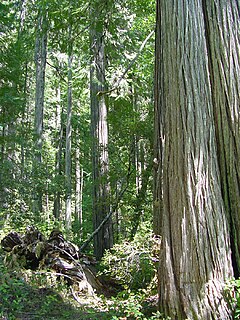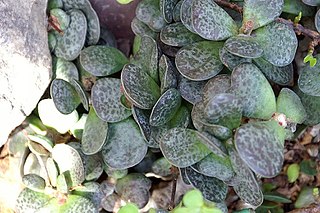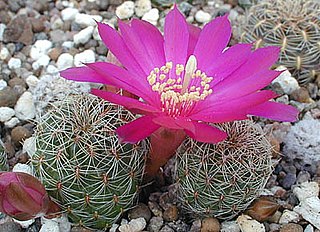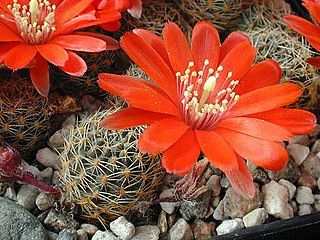
The Royal Horticultural Society (RHS), founded in 1804 as the Horticultural Society of London, is the UK's leading gardening charity.

Chamaecyparis lawsoniana, known as Port Orford cedar or Lawson cypress, is a species of conifer in the genus Chamaecyparis, family Cupressaceae. It is native to Oregon and northwestern California, and grows from sea level up to 1,500 m (4,900 ft) in the valleys of the Klamath Mountains, often along streams.

John Lindley FRS was an English botanist, gardener and orchidologist.

The Award of Garden Merit (AGM) is a long-established annual award for plants by the British Royal Horticultural Society (RHS). It is based on assessment of the plants' performance under UK growing conditions.

Celosia argentea, commonly known as the plumed cockscomb or silver cock's comb, is a herbaceous plant of tropical origin, and is known for its very bright colors. In India and China it is known as a troublesome weed.

Lavandula angustifolia, formerly L. officinalis, is a flowering plant in the family Lamiaceae, native to the Mediterranean. Its common names include lavender, true lavender or English lavender ; also garden lavender, common lavender, and narrow-leaved lavender.

Caputia tomentosa, known as the woolly senecio and the matted caputia, is a perennial, succulent dwarf shrub of the Caputia genus that grows in the Cape Provinces of South Africa, usually between the altitudes of 900 and 1200 meters. It has been introduced to Myanmar. It has gained the Royal Horticultural Society's Award of Garden Merit as an ornamental.

Symphyotrichum ericoides, known as white heath aster, frost aster, or heath aster, is a species of flowering plant in the family Asteraceae native to much of central and eastern North America. It has been introduced to parts of Europe and western Asia.

RHS Garden Rosemoor is a public display garden run by the Royal Horticultural Society in north Devon, England.

Echinopsis oxygona is a species of flowering plant in the cactus family Cactaceae, native to South Brazil, Uruguay and northern Argentina. Its features include: many robust spines, spherical shape, and a large flower, with sharply pointed lavender or white petals, and a fine faint scent.

Genista tinctoria, the dyer's greenweed or dyer's broom, is a species of flowering plant in the family Fabaceae. Its other common names include dyer's whin, waxen woad and waxen wood. The Latin specific epithet tinctoria means "used as a dye".

Hydrangea aspera is a species of flowering plant in the family Hydrangeaceae, native to the region between the Himalayas, across southern China, to Taiwan. It is a large, erect deciduous shrub growing to 3 m (10 ft) tall and wide, with broadly oval leaves. The flowers are typically borne in large flat heads in late summer, and are in variable shades of pale blue and pink, fringed by white or pale pink sterile florets.

Eriocapitella hupehensis, a species of flowering plant in the buttercup family Ranunculaceae, is native to Asia. The specific epithet hupehensis, which means "from Hupeh province, China", refers to a region where the species is known to occur. In Chinese, it is called dǎ pò wǎn huā huā (打破碗花花), which means "broken bowl flower".

Adromischus maculatus, the spotted adromischus or calico hearts, is a species of flowering plant in the family Crassulaceae, which is endemic to the Eastern Cape and Western Cape of South Africa.

Lachenalia corymbosa, the corymbous Cape cowslip, is a species of flowering plant in the genus Lachenalia native to the southwest Cape Provinces of South Africa. It has gained the Royal Horticultural Society's Award of Garden Merit.

Rebutia canigueralii is a species of cactus in the genus Rebutia, native to Bolivia. It has gained the Royal Horticultural Society's Award of Garden Merit.

Rebutia pygmaea is a species of cactus in the genus Rebutia, native to Bolivia and northwest Argentina. It has gained the Royal Horticultural Society's Award of Garden Merit.

Euonymus carnosus, called the fleshy‑flowered spindletree, is a species of flowering plant in the genus Euonymus, native to southeast and south‑central China, Taiwan, the Bonin Islands, the Ryukyu Islands, and Japan. It has gained the Royal Horticultural Society's Award of Garden Merit.

Eriocapitella is a genus of flowering plants in the buttercup family Ranunculaceae. Plants of the genus are native to Asia. The generic name Eriocapitella roughly translates to "growing in a small woolly head", which refers to the hairy ovary and fruit of some members of the genus. Cultivated plants are commonly known as fall-blooming anemones.

Eriocapitella × hybrida is a hybrid of flowering plants in the buttercup family Ranunculaceae. The parents of the hybrid are E. japonica and E. vitifolia. Cultivars of the hybrid are commonly known as Japanese anemone hybrids.




















